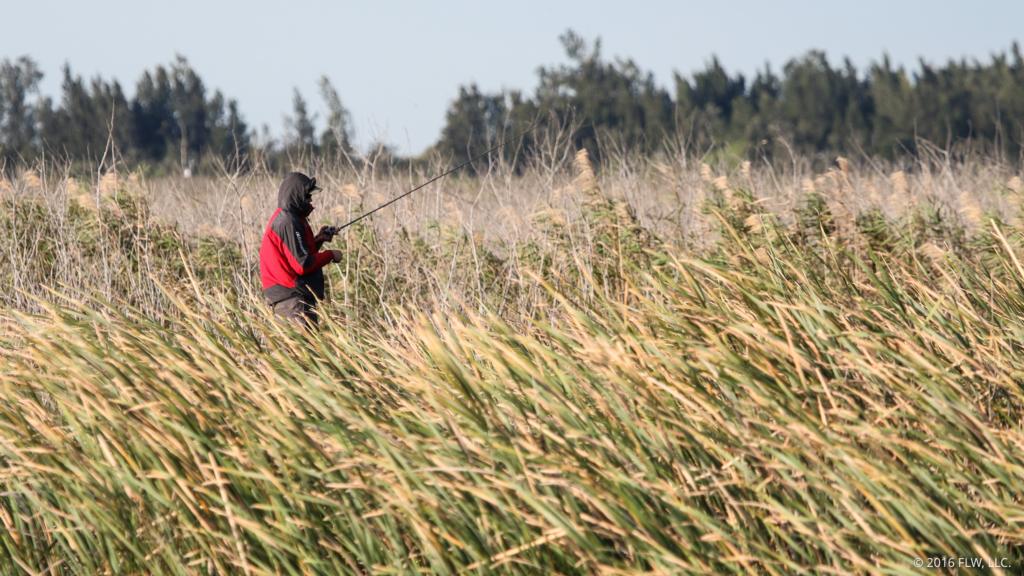An Ill Wind at Okeechobee?
Success or failure often hangs in the wind in south Florida

The wind can be a bass fisherman’s best friend or worst enemy. The anglers fishing day two of the Walmart FLW Tour event presented by Ranger Boats on Lake Okeechobee are fully aware of that.
On its best behavior, the wind creates a temporary current, positions baitfish and helps an angler move around more stealthily in shallow water.
At its worst, wind can have just the opposite effect, wrecking the best-laid plans so carefully formulated by an angler. The stories of pros having their plans go down the tubes because wind pushed muddy water into their best spots are legion.
Mike Surman has his own tale of woe, which occurred many years ago on Okeechobee during a B.A.S.S. tournament. Like this week on Okeechobee, it was scheduled for a time when the big lake should have been at its best.
It was – for a while. For the first two days, a soft southwesterly wind blew through the southern end of the lake where Surman had located prespawn and spawning bass. He had averaged about 40 fish per day and led the tournament by several pounds ahead of the closest competitor.
“The evening before the last day, I knew that the weather forecast called for a front to come through,” recalls the south Florida pro. “That in itself wasn’t bad because the temperature really wasn’t supposed to go down that bad. But it would change the wind direction. I figured, what the heck, I’ve been catching 40 fish a day, and I can get five more good ones even if it isn’t the best of conditions. Wrong – the wind was howling at about 30 mph and blew muddy water in there. I didn’t catch anything and then ran to the north side with about two hours to go. I caught four fish for about 8 pounds, and Gary Klein won the tournament. He’d been fishing up there the whole time.”
Moral of the story: Have a plan B that takes into account a change in wind direction, or a change in water conditions. In most tournament situations, the wind isn’t such a critical factor, unless it affects boat traffic. At Okeechobee, however, it can be a heartbreaker.
This week on Okeechobee, pros started the tournament on the tail end of a three-day southerly blow. Last night it switched, and today's north wind has blown as hard as 20 mph. The air temperature also took a plunge, and along with rainfall last night has resulted in a drop in the water temperature of a few degrees.
“When you’re fishing a big, shallow bowl of a lake like Okeechobee, the wind plays a huge factor,” he says. “Because it’s shallow, a fairly strong wind can literally stir up the bottom and cause muddy water to move in somewhere downwind fairly quickly. A little wind is good, because it helps cover up your movements. You don’t want it slick calm. A wind that causes a ripple on the surface keeps the baitfish more active, too, and that can be good for fishing.”
The anglers who are punching mats or fishing reeds also can benefit from a constant breeze and even a drop in temperature, as it tends to congregate fish in the tightest cover. Depending on which way the wind is blowing and how sustained it is, the water is “piled up” on the downwind side by as much as a foot.
If an angler is fishing fairly shallow grass on the leeward side, he might find that his water and his fish have left at some point. If he’s windward, he might benefit from higher water that encourages fish to move in and make the shallows more accessible to him.
That presupposes the water won’t muddy up too bad, but even if it does, it might not wreck the fishing.
Surman is a lot wiser than he was when he had the bad third day on Okeechobee that robbed him of a big purse. Now he knows he can catch fish even if muddy water flows in on him like a tan cloud.
“You’d be surprised how many fish you can catch out of dirty water on Okeechobee. Some of them might leave, but if there’s something there that they want to eat, a lot of them will stay in an area. You have to switch to a bait they can feel in the water rather than a bait they can see,” he advises. “My favorite is a Yo-Zuri Rattl’n Vibe. The trick is to cover a lot of water without fishing too fast.”
Punching in the grass, swimming jigs around the buggy whip reeds, casting to spawners out on the flats – all were in play at tournament’s start. Now all bets are off. It's a new tournament. Some pros might end up looking back on this as a missed opportunity, as Surman recalls of his own shortfall. But others have an opportunity to move up the standings and make the top-20 cut.